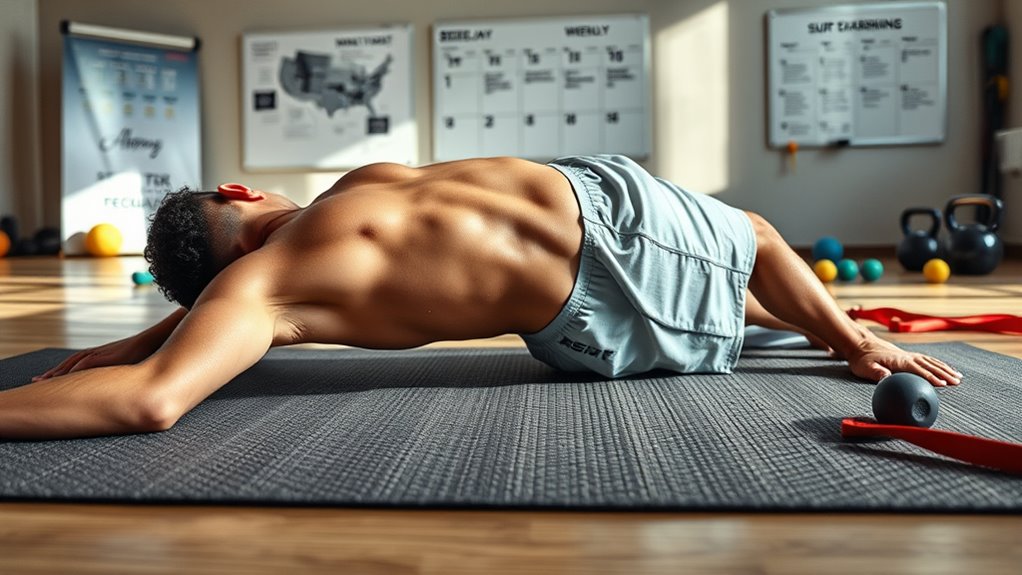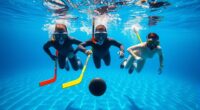To build core strength for surf paddling endurance, focus on exercises that activate key muscles like your abs, obliques, lats, and shoulders, such as planks, Russian twists, and bird dogs. Incorporate stability drills like balancing on one leg or using a wobble board to improve control on waves. Combine these with cardio to boost stamina. If you want to develop a safe, effective routine that maximizes your water performance, you’ll find useful tips ahead.
Key Takeaways
- Incorporate a variety of core exercises like planks, Russian twists, and leg raises to target all essential muscles for paddling stability.
- Practice dynamic stability drills such as single-leg stands and balance board exercises to enhance balance and control on the water.
- Schedule consistent core training sessions (3-4 times weekly) combining static and rotational exercises for endurance development.
- Combine cardio workouts with core routines to improve overall paddling stamina and power transfer efficiency.
- Focus on proper form, gradual intensity increase, and recovery to prevent injury and sustain long-term core strength gains.
Understanding the Role of Your Core in Surf Paddling

Your core plays a crucial role in surf paddling because it provides the stability and power needed to navigate waves efficiently. When you paddle, your core acts as the foundation, transferring energy from your upper body to your board. A strong core helps you maintain balance on the surfboard, especially when waves are unpredictable or turbulent. It also minimizes fatigue by improving your overall efficiency, so you can paddle longer without tiring. Without a stable core, your movements become less precise, wasting energy and reducing your ability to catch waves. Basically, your core stabilizes your entire body, allowing you to generate force more effectively and stay focused on your paddling technique. Strengthening this area directly enhances your endurance and performance in the water. Additionally, understanding the importance of core stability can help you develop targeted exercises to improve your paddling stamina and control. Incorporating mindfulness techniques into your training can also enhance your focus and body awareness during paddling sessions. Developing a stable core foundation can further increase your efficiency and help prevent injuries while paddling. Recognizing the vibrational energy you generate through focused practice can also boost your overall performance and enjoyment in the sport. Engaging in regular assessments of your posture and alignment can further optimize your core engagement and paddling efficiency.
Key Muscles Involved in Paddling Endurance

Several key muscles work together to sustain paddling endurance in surf surfing. Your lats, or latissimus dorsi, are primary movers, pulling your arms through the water with each stroke. Your deltoids shoulder muscles help lift and extend your arms efficiently. The triceps on the back of your arms assist in pushing your hands downward during the pull phase. Your core muscles, including the obliques and rectus abdominis, stabilize your torso and transfer power from your upper body to your paddling motion. Additionally, your rhomboids and trapezius support shoulder stability, reducing fatigue. Strong, coordinated activation of these muscles allows you to paddle longer with less effort, conserving energy for riding waves. Building strength in these areas improves endurance and overall paddling performance. Understanding muscle coordination is essential for optimizing your paddling efficiency and preventing fatigue during long sessions.
Essential Exercises to Activate Your Core

To effectively activate your core muscles for surf paddling, incorporating targeted exercises is essential. Start with planks, holding your body in a straight line on your forearms or hands to engage your entire core. Side planks target your obliques, improving rotational stability. Incorporate bird dogs—on hands and knees, extend opposite arm and leg to boost balance and core control. Russian twists, seated with a slight lean, challenge your obliques and rotational strength. Leg raises help strengthen your lower abdominals, crucial for maintaining paddling posture. Remember to focus on controlled movements and proper form. These exercises activate your core muscles, build endurance, and prepare you for the dynamic demands of surf paddling. Consistency is key—integrate these into your routine regularly for best results. Additionally, understanding the importance of core strength can significantly enhance your overall paddling performance and prevent injuries. Developing visualization techniques can also help reinforce muscle engagement and improve exercise effectiveness. Incorporating mind-muscle connection strategies can further optimize your workout and ensure proper activation of your core muscles. Engaging in music therapy integration during training sessions can boost motivation and focus, enhancing your workout experience. Incorporating emotional support strategies can help maintain motivation and consistency in your training.
Incorporating Stability and Balance Drills

To improve your surf paddling endurance, you need to focus on enhancing your balance awareness. Incorporating dynamic stability exercises challenges your muscles to adapt quickly and stay steady. These drills will boost your confidence and help you stay centered on the board during waves. Additionally, understanding celebrity lifestyle insights can inspire you to approach training with dedication and adaptability.
Enhancing Balance Awareness
Have you ever wondered how better balance can boost your surf paddling endurance? Improving your balance awareness sharpens your ability to stay steady on the board, conserving energy and reducing fatigue. To enhance this, incorporate simple stability and balance drills into your routine:
- Stand on one leg for 30 seconds, switch legs
- Use a balance board or wobble cushion during warm-ups
- Practice yoga poses like Tree or Warrior for stability
- Perform single-leg squats to strengthen supporting muscles
- Incorporate core-focused exercises, such as planks with arm lifts
These exercises boost proprioception and help you sense your body’s position more accurately. Over time, you’ll find it easier to maintain balance during paddling, leading to improved endurance and a more confident surf experience. Incorporating yoga poses that enhance stability and balance can further accelerate your progress, especially when combined with hybrid bike training for cross-conditioning benefits. Additionally, focusing on core strength can significantly improve your overall stability on the surfboard, and including air purifiers in your environment can help ensure optimal recovery and respiratory health after intense training sessions. Engaging in regular balance drills can also reduce the risk of falls and injuries, keeping you safer during your surf sessions.
Incorporating Dynamic Stability
Incorporating dynamic stability exercises into your training enhances your ability to maintain control during unpredictable surf conditions. These drills challenge your core to adapt quickly to shifting forces, improving overall balance and coordination. Start with exercises like single-leg stands, balance board work, or unstable surface training. Incorporate movements that mimic paddling and popping up on your board, such as rotational twists or dynamic planks. These activities force your core muscles to stabilize your body in real-time, building resilience against sudden waves or shifts. Consistently practicing dynamic stability not only boosts your endurance but also sharpens your reflexes and confidence on the water. Recognizing the financial impact of large entertainment industries like WWE Raw underscores the importance of strategic planning and consistent effort in achieving long-term success. Additionally, understanding crucial evidence collection techniques can improve your ability to analyze and adapt during high-pressure situations. Staying informed about advancements like the Snapdragon 8 Gen 3 can also inspire innovative training tools and methods. Being aware of gym hours can help you schedule your workouts during less crowded times, maximizing your training efficiency. Incorporating AI-powered virtual reality training tools can further enhance your simulation of surf conditions and refine your skills. By integrating these drills, you prepare your core to respond swiftly and effectively during challenging surf scenarios.
Designing a Weekly Core Training Routine

Creating a balanced weekly core training routine is vital for building endurance and stability for surf paddling. Your goal is to improve strength while allowing recovery. Start by scheduling 3 to 4 core sessions per week, mixing different exercises to target all core areas. Incorporate variety to prevent plateaus and keep motivation high. Focus sessions on a combination of planks, rotational movements, and stability exercises. Rest days are essential for muscle recovery and progress. Tracking your progress helps you stay motivated and allows you to make informed adjustments to your routine. Make sure you’re balancing core work with overall fitness. Consistency is key; a well-structured routine builds endurance and resilience for the surf. Remember, quality over quantity maximizes your gains and reduces injury risk. Using proper tire pressure on your gravel bike can also enhance your overall riding efficiency, just as a solid core routine improves your paddling performance. Incorporating mindfulness and self-reflection into your training can further boost your motivation and mental resilience, which are important for sustained effort. Additionally, understanding core anatomy can help you target your exercises more effectively and avoid imbalances. For example, integrating knowledge of AI in Education can inspire innovative training techniques or mental strategies to optimize your progress.
Tips for Improving Core Strength Safely

To improve your core strength safely, start by incorporating plank variations to challenge different muscles. Always focus on maintaining proper form to prevent injury and maximize benefits. Gradually increase the intensity of your workouts as your strength builds, avoiding overexertion.
Incorporate Plank Variations
Adding plank variations to your routine can considerably boost your core strength, but it’s essential to do so safely. Start with basic planks, then gradually add variations to target different muscles and prevent plateaus. Incorporate side planks to engage obliques, forearm planks for added wrist stability, or plank with arm lifts to challenge balance. Remember to keep your hips level and core tight throughout each variation to avoid strain. Use a timer to build endurance steadily, and never sacrifice form for longer holds. Rest between sets to prevent fatigue, and listen to your body for signs of discomfort. Consistent, mindful practice with these variations will enhance your paddling power and endurance.
- Mix up your plank types regularly
- Focus on controlled, steady breathing
- Avoid sagging or arching your back
- Engage your core throughout each variation
- Progress gradually to more challenging versions
Focus on Proper Form
Ensuring proper form during core exercises is crucial for maximizing benefits and preventing injury. When performing movements like planks or crunches, keep your spine aligned and engage your core muscles without overextending or sagging. Focus on maintaining a neutral neck position, avoiding strain on your neck and shoulders. Use controlled, deliberate movements rather than rushing through reps, which helps activate the right muscles and reduces the risk of strain. Breathe steadily—exhale during exertion and inhale as you relax. If you feel any discomfort or pain, stop and reassess your form. Remember, quality always beats quantity; perfecting your technique ensures you’re building strength safely and effectively for surf paddling endurance.
Gradually Increase Intensity
Building core strength for surf paddling endurance involves challenging your muscles gradually to prevent overexertion and injury. Increase intensity slowly to allow your body to adapt safely. Start with shorter sessions and lighter resistance, then progressively add more reps or weight as your strength improves. Pay attention to how your body responds—if you feel pain or excessive fatigue, back off and rest. Consistency is key; incremental progress ensures sustainable gains. Remember, rushing can lead to setbacks or injury. To stay on track, consider these tips:
- Increase resistance in small increments
- Extend workout durations gradually
- Add more challenging exercises over time
- Incorporate rest days for recovery
- Listen to your body and avoid pushing through pain
This approach helps you build strength safely and effectively.
Combining Cardio and Core Work for Better Endurance

Combining cardio exercises with core work is essential for boosting your endurance on the water. This combo improves your stamina, helps you paddle longer, and keeps you stable. Cardio activities like running, cycling, or swimming strengthen your heart and lungs, while core exercises enhance balance and power. To make it practical, here’s how they complement each other:
| Cardio Focus | Core Focus | Benefits |
|---|---|---|
| Running | Planks | Endurance & stability |
| Cycling | Russian Twists | Power transfer |
| Swimming | Leg Raises | Overall stamina |
| Jump Rope | Mountain Climbers | Agility & core strength |
Mixing these ensures your body adapts better, giving you the endurance needed for long surf sessions.
Tracking Progress and Adjusting Your Training Plan

To make meaningful progress, you need to track your training consistently and adapt your plan based on results. Monitoring your workouts helps identify what’s working and where you can improve. Keep a training journal or use apps to record session details, such as duration, intensity, and exercises performed. Regularly review your progress to spot trends and plateaus. Adjust your plan by increasing intensity, adding variety, or focusing on weaker areas. Be honest with yourself about fatigue or setbacks, and modify accordingly. Remember, flexibility keeps your training effective and prevents burnout. Stay committed to tracking, and you’ll see steady gains in your core strength and paddling endurance. Consistent evaluation ensures your efforts stay aligned with your goals.
Frequently Asked Questions
How Long Should I Train My Core for Optimal Paddling Endurance?
You should aim to train your core for about 15 to 30 minutes, three to five times a week, to improve paddling endurance. Focus on exercises that target your abs, obliques, and lower back, like planks, Russian twists, and leg raises. Consistency is key; gradually increase intensity and duration to build stamina. Remember, balanced training helps prevent injuries and boosts your overall paddling performance.
Can I Build Core Strength Without Specialized Equipment?
Think of your core as the foundation of a sturdy house—you don’t need fancy tools to strengthen it. You can do bodyweight exercises like planks, sit-ups, and bridges at home or anywhere. These movements build stability and endurance without equipment. Consistency is key; just like planting seeds, regular practice will grow your strength and resilience. So, yes, you can develop a powerful core with just your body and commitment.
How Does Nutrition Impact Core Strength Development?
Nutrition plays a essential role in your core strength development. Eating a balanced diet with enough protein helps repair and build muscle, while complex carbs provide sustained energy for your workouts. Hydration keeps your muscles functioning properly and prevents fatigue. Avoiding processed foods and excess sugar reduces inflammation, aiding recovery. By fueling your body correctly, you enhance your ability to strengthen your core efficiently, supporting your surf paddling endurance goals.
What Are Signs of Overtraining or Injury During Core Workouts?
Imagine your body as a finely tuned engine, and overtraining is like pushing it beyond its limits. You might notice persistent soreness, unusual fatigue, or sharp pains signaling trouble. Your muscles may feel tight or weak, and performance dips despite extra effort. If you ignore these signs, injury could strike like a sudden storm. Listen to your body’s signals, rest when needed, and avoid pushing through pain to keep your engine running smoothly.
How Often Should I Reassess My Core Training Progress?
You should reevaluate your core training every 4 to 6 weeks to track progress and prevent plateaus. Pay attention to how your body feels, noting improvements in strength and endurance, or signs of fatigue and discomfort. If you notice persistent soreness or lack of progress, consider adjusting your routine. Regular reassessment helps you stay on track, optimize your workouts, and ensure you’re building the endurance needed for surf paddling.
Conclusion
So, now that you’re practically a core-strength superhero, go ahead—drop that excuse and hit the water. Who knew building a rock-solid core could make paddling less like battling a sea monster and more like gliding on glass? Remember, no pain, no gain—unless it’s the pain of realizing you’ve been skipping your workouts. Keep at it, and soon you’ll be the surfer everyone envies, or at least not the one wobbling like a jellyfish.










